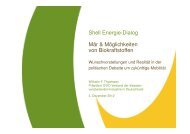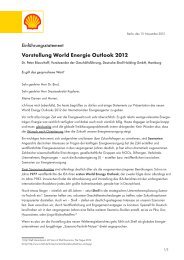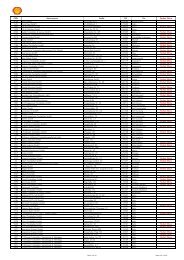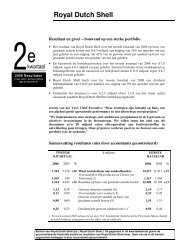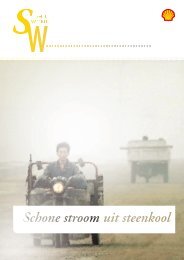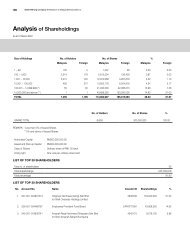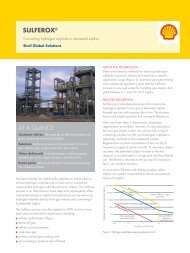ENVIRONMENTAL STATEMENT BARDOLINO DEVELOPMENT
ENVIRONMENTAL STATEMENT BARDOLINO DEVELOPMENT
ENVIRONMENTAL STATEMENT BARDOLINO DEVELOPMENT
Create successful ePaper yourself
Turn your PDF publications into a flip-book with our unique Google optimized e-Paper software.
Bardolino Development Environmental Statement<br />
and shipping activity in the area (Section 4.5.2) is moderate overall for this area of the central<br />
North Sea.<br />
Guard boats would be used to monitor vessel activity in the area during the pipeline<br />
operations.<br />
Once buried by rock dump or natural sediment infill, the physical presence of the pipelines<br />
and umbilical would pose no threat to bottom-towed fishing gear; the pipelines and umbilical<br />
would be trenched so that the top of the pipe is a minimum of 1.0 m below the natural seabed.<br />
Areas at either end of the pipelines that are not trenched, such as the tie-in spools, would be<br />
designed so as to prevent the snagging of fishing gear and shall be protected from dropped<br />
objects using concrete protection mats. In addition, the transition zones would lie within the<br />
statutory 500 m exclusion areas at Bardolino and the Howe subsea manifold. It is therefore<br />
concluded that the very local, temporary disturbance to the benthic community would be<br />
outweighed by the benefits gained by trenching, backfilling and/or rock dumping the pipelines<br />
to eliminate potential interactions with fishing gear.<br />
The location and profile of the spot rock dump material would be made available to fishermen<br />
and fishing interests. The blanket rock dump rock dump would be below the level of the<br />
trench.<br />
The tie-in spools and concrete mattresses protecting them would create new habitats for<br />
benthic organisms that live on hard surfaces. Such organisms typically include tubeworms,<br />
barnacles, hydroids, tunicates and bryozoans, which are commonly found on submerged<br />
rocky outcrops, boulders and offshore structures. These structures could also provide<br />
habitats for crevice-dwelling fish (e.g. ling) and crustaceans (e.g. squat lobsters and crabs).<br />
The overall disturbance would be negligible, as these structures will cover only a small area of<br />
the seabed.<br />
6.5.3 Contribution to transboundary, cumulative or global impacts<br />
The installation of the pipelines and umbilical would cause localised temporary disturbance<br />
and interference along corridors of seabed estimated to cover a total area of approximately<br />
0.02 km 2 . The pipeline and umbilical installation operations would all be within UK waters, so<br />
there would be no transboundary impacts. Over the past decade, several pipelines have<br />
been installed in this area of the North Sea, but the installation of the proposed 2km long<br />
buried Bardolino pipelines and umbilical is unlikely to result in any cumulative impacts.<br />
The concrete mattresses that would be placed to protect the untrenched ends of the pipelines<br />
would be located within the 500 m safety exclusion zones, and would therefore not represent<br />
a cumulative impact on fishing.<br />
Spot rock dumping the pipelines would alter the character of a very small proportion of the<br />
seabed; sediment movement would begin to re-establish the natural seabed surface at these<br />
areas.<br />
There would be no global impacts.<br />
6.5.4 Consultee concerns<br />
JNCC advised that survey data for the pipeline should ideally be presented within the ES.<br />
However, as the planned pipeline is only 2 km long, and 1 km of it will be within the 500m<br />
zones of Howe and Bardolino, JNCC suggested that, on this occasion, if the data were not<br />
available the ES should describe the survey work to be undertaken, with the complete results<br />
being included in the subsequent PON 15s.<br />
6.5.5 Adequacy of proposed mitigation measures<br />
A 3 km by 3 km rig site survey was undertaken for the Bardolino well location, which<br />
encompasses the planned pipeline route corridor between Howe and Bardolino, to gain<br />
detailed information on bathymetry (Gardline Geosurvey Limited, 2007). No unusual seabed<br />
April 2008 Page 6-15


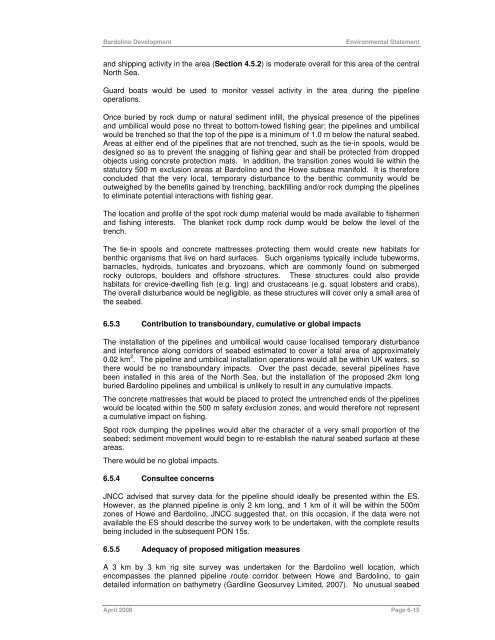
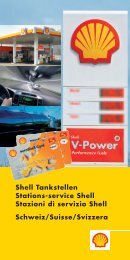
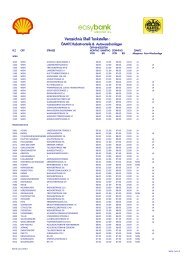
![Download Shell AutoGas Stationen [Stand: Januar 2013] (PDF](https://img.yumpu.com/9982753/1/190x245/download-shell-autogas-stationen-stand-januar-2013-pdf.jpg?quality=85)
